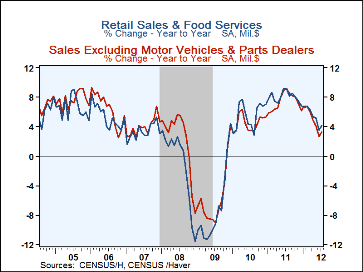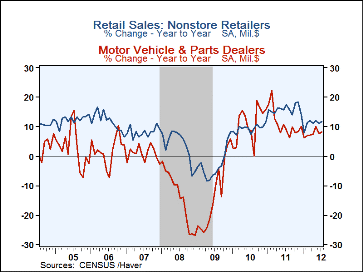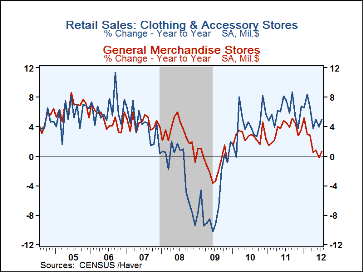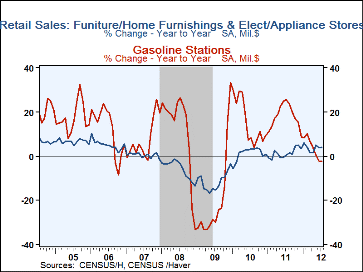 Global| Aug 14 2012
Global| Aug 14 2012U.S. Retail Sales Gain After Falling For Three Months
by:Tom Moeller
|in:Economy in Brief
Summary
Finally the consumer grew tired of not spending and July retail sales rose 0.8%. The gain followed a deepened 0.7% June drop and a downwardly revised 0.1% May dip. A 0.3% increase in July sales was expected according to Action [...]
Finally the consumer grew tired of not spending and July retail sales rose 0.8%. The gain followed a deepened 0.7% June drop and a downwardly revised 0.1% May dip. A 0.3% increase in July sales was expected according to Action Economics. Less autos, retail sales rose 0.8% versus expectations for a 0.4% rise. Nonauto sales declined 0.8% in June and 0.3% in May, both of which were revised deeper.
Sales of building materials provided much of recent month's sales weakness. A 1.0% July recovery (+1.0% y/y) followed three months of decline between 2.1% and 3.2%. Lower gasoline prices also have depressed recent month's total spending. A 0.5% gain (-2.6% y/y) last month followed three months of decline between 1.7% and 3.4%. Auto sales rose 0.8% (8.2% y/y) in July. Less these three categories July sales rose 0.9% (3.8% y/y) after a 0.2% June drop.
Discretionary spending fared better last month as indicated by a 1.0% rise (4.2% y/y) in sales of home furnishings, appliances and electronics. Furniture store sales rose 1.1% (9.9% y/y) while appliance and electronics purchases gained 0.9% (-0.8% y/y). Sales of apparel & accessory stores also increased 0.8% (5.0% y/y) following moderate gains in the prior two months. Sales of general merchandise rose 0.7% (0.6% y/y) following four consecutive monthly declines. Food & beverages store sales gained 0.8% (7.3% y/y). Sales of nonstore retailers rose a strong 1.5% (11.8% y/y), the strongest gain of the last four months.
The retail sales figure are available in Haver's USECON database. The Action Economics figures are in the AS1REPNA database.
| Retail Spending(%) | Jul | Jun | May | Jul Y/Y | 2011 | 2010 | 2009 |
|---|---|---|---|---|---|---|---|
| Total Retail Sales & Food Services | 0.8 | -0.7 | -0.1 | 4.1 | 8.0 | 5.5 | -7.1 |
| Excluding Autos | 0.8 | -0.8 | -0.3 | 3.2 | 7.3 | 4.5 | -5.7 |
| Retail Sales | 0.8 | -0.8 | -0.1 | 3.7 | 8.2 | 5.8 | -7.9 |
| Motor Vehicle & Parts | 0.8 | -0.5 | 0.8 | 8.2 | 10.9 | 10.8 | -13.9 |
| Retail excluding Autos | 0.8 | -0.9 | -0.3 | 2.7 | 7.6 | 4.7 | -6.4 |
| Gasoline Stations | 0.5 | -3.4 | -2.2 | -2.6 | 17.9 | 14.7 | -22.0 |
| Non-Auto Less Gasoline | 0.9 | -0.4 | 0.0 | 3.6 | 5.9 | 3.2 | -3.4 |
| Food Service | 0.8 | -0.2 | -0.3 | 7.3 | 5.9 | 3.2 | -0.9 |
Tom Moeller
AuthorMore in Author Profile »Prior to joining Haver Analytics in 2000, Mr. Moeller worked as the Economist at Chancellor Capital Management from 1985 to 1999. There, he developed comprehensive economic forecasts and interpreted economic data for equity and fixed income portfolio managers. Also at Chancellor, Mr. Moeller worked as an equity analyst and was responsible for researching and rating companies in the economically sensitive automobile and housing industries for investment in Chancellor’s equity portfolio. Prior to joining Chancellor, Mr. Moeller was an Economist at Citibank from 1979 to 1984. He also analyzed pricing behavior in the metals industry for the Council on Wage and Price Stability in Washington, D.C. In 1999, Mr. Moeller received the award for most accurate forecast from the Forecasters' Club of New York. From 1990 to 1992 he was President of the New York Association for Business Economists. Mr. Moeller earned an M.B.A. in Finance from Fordham University, where he graduated in 1987. He holds a Bachelor of Arts in Economics from George Washington University.










